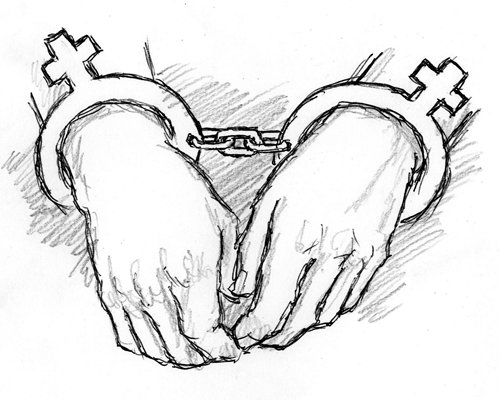
Illustrations: Peter C. Espina/GT (Photo: Global Times)
The idea of women-only train carriages has never been far from being a bone of contention for more than a decade. Lately, a New York Times feature on men cramming into women-only subway cars in a southern China metropolis has brought the subject under glare once again.
The article, published in the prestigious daily Monday, has roiled Chinese public opinion. It closely examined how throngs of men elbow into subway compartments designated for women during weekday rush hours in Guangzhou, a bustling city with the world's fourth busiest metro system. Also presenting women's divergent views on this disturbing phenomenon, the author exposed "the problem" of men claiming seats and space reserved for female passengers by Guangzhou metro to curb sexual harassment.
Some netizens, mostly working men, responded that it's too crowded to recognize the two special cars at the back of the train labeled with pink characters "for ladies" and flower drawings. Many feminists are angry that the policy in itself is a tacit approval of women's lower social status and will exacerbate gender antagonism. Others complain that segregation on public transport is not a good idea in that it has barely worked in several countries.
A women-only carriage packed with men is not a rare sight. In the urban metro systems of crowded Japanese cities from Tokyo, Sapporo, Osaka to Nagoya, female commuters are frequently annoyed by men squeezing into women's cars with boxy briefcases. They remain at risk of being groped as they did a dozen years ago when there was no segregated space for women. For male office workers, they would rather take less cramped women's cars than risk getting fined for being late to work.
But there's no denying that the policy has achieved results in a few cities where rail authorities adopt strong punitive measure against violators. In New Delhi, women, usually "disrespected in most public places" according to a local journalist on NPR, look carefree in the passenger compartments reserved for them. Stations there have heavy security apart from surveillance cameras. When a man flouts the rules, a policeman will come up quickly to persuade him to leave or fine him Rs250 (about $4). The measure has been effective around India now that Mumbai and Kolkata have had women's carriages for decades. And in Iran, segregated carriages for women have become part of the culture.
It is fair to say that the introduction of women's carriages in response to sexual assault has seen mixed results. But not every station has enough guards to usher away male passengers during peak traveling hours. And there are few or no laws that mandate punishment for those who ignore the rules.
Actually, not stepping into women's cars is more of an issue of morality and etiquette than law enforcement. The policy is well-intentioned, but can hardly lead to the end of sexual harassment. Nothing different from asking girls to wear more clothes at night or change their routes to avoid being followed by mischief-mongers, it takes us a step back in the modern battle for gender equality.
That's why "Ladies Only" compartments, which had been in place for a century since the Victorian era, were abolished on British trains in 1977, two years after the UK Parliament passed the Sex Discrimination Act. And Labor Party leader Jeremy Corbyn had to do away with his proposal of reviving women-only carriages in 2015 given massive public furor.
Do women really need a segregated passenger car to stay away from sexual offences? What if they are assaulted while not sitting in it? If it were me, I would be reluctant to report an incident because I will feel it was my fault for not sitting where a woman is supposed to.
Besides fomenting a victim-blaming mentality in women, the policy is an insult to men by taking it for granted that men are innate sexual predators who can do anything outside women-only passenger cars.
Any respect shown to women that labels them as meek and submissive risks reinforcing gender roles, squandering efforts at gender parity.
By introducing segregated cars, transport authorities have at least shown care for women. But what's the best, most efficient way to prevent sexual harassment and reach gender equality is worth mulling over.


